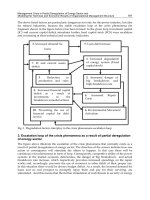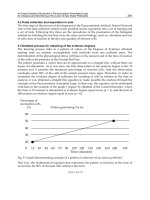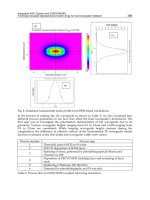COGNITION AND ECONOMICS PART 11 pot
Bạn đang xem bản rút gọn của tài liệu. Xem và tải ngay bản đầy đủ của tài liệu tại đây (88.24 KB, 10 trang )
NOTE ON BEHAVIORAL
ECONOMICS
Nick Schandler
Much recent work in the area of behavioral economics has concentrated on
so-called ‘‘behavioral anomalies.’’ These behavioral anomalies are seeming
departures from the fundamental economic assumption of rational
behavior.
1
They suggest that economics actors are not maximizing utility
subject to the relevant constraints as standard theory predicts. Rather, ac-
tors seem to be ‘‘leaving money on the table’’ when a costless alteration of
behavior could result in superior outcomes. Some researchers have con-
tented themselves with explaining such anomalies and declaring such actions
‘‘irrational.’’ Other researchers see opportunity: each anomaly presents us
with the problem of asking why actors choose to behave in ways that seem
to contradict standard behavioral assumptions. The former indict the
actors; the latter his assumptions.
Among the second group of actors are the many economists who have
attempted to explain such anomalies through the concept of bounded
rationality. Work on bounded rationality has focused on the actor’s limited
cognitive abilities and knowledge to explain otherwise irrational behavior.
Since there is a ‘‘cost’’ to thinking, actors may choose to act according to
habits or ‘‘rules of thumb,’’ even though such rules may frequently result in
sub-optimal outcomes. An attempt to process every bit of information
available before acting would leave one frozen, unable to make even the
most routine of decisions. Rather, individuals’ rationality is bounded by its
Cognition and Economics
Advances in Austrian Economics, Volume 9, 275–284
Copyright r 2007 by Elsevier Ltd.
All rights of reproduction in any form reserved
ISSN: 1529-2134/doi:10.1016/S1529-2134(06)09013-2
275
limited information processing capacity. We develop heuristics and habits
that enable us to perform basic, everyday actions without attempting to fit
these into some utility-maximizing framework.
This idea of bounded rationality is often invoked to explain many of the
so-called behavioral anomalies. According to this approach, we should not
expect individuals to follow some utility-maximizing path through time,
constantly re-adjusting to equate costs and benefits at the margin with every
changing circumstance. Such behavior is simply too costly, too taxing on
our cognitive resources.
Vernon Smith (2003) has touched on a slightly different approach. In his
2002 Bank of Sweden Prize in Economic Sciences in Memory of Alfred
Nobel, he drew a distinction between constructivist rationality and ecological
rationality in economics. The constructivist approach views all social insti-
tutions as the product of conscious, deductive reasoning starting from self-
evident premises. By contrast, ecological rationality views rationality as a
phenomenon that emerges out of cultural and biological evolutionary proc-
esses. Human behavior comprises elements of both types of rationality. While
many of our behaviors can be seen as constructively rational, such as when we
manage our investment portfolio to achieve a specific risk–reward balance,
the majority of our behavior is not so deliberately calculated. One is simply
unable to calculate the ‘‘optimal’’ basket of groceries in a store carrying
30,000 items.
These differing views of rationality have found relevance in today’s lit-
erature on behavioral anomalies. Such anomalies have been analyzed largely
through the lens of constructivism, and are, from this standard, both de-
ficient and anomalous. But from an ecological perspective, such anomalies
may be seen as fully rational responses to our limited knowledge concerning
the relevant knowledge and effects of our actions.
THE WINNER’S CURSE
The ‘‘winner’s curse’’ (or, more precisely, failure to account for the winner’s
curse) was one of the first behavioral ‘‘anomalies’’ to be discussed in the
literature. The idea dates back to 1971, and was first applied to the bidding
for oil drilling rights (See Capen, Clapp, & Campbell, 1971). The winner’s
curse is the phenomenon of systematically upward-biased winning bids in an
auction market. That is, the winning bid in an auction tends to be much
higher than some objectively defined value of the good.
2
The basis of the
anomaly is relatively simple. In an auction with a large number of buyers,
NICK SCHANDLER276
each possessing imperfect information concerning the value of the auctioned
good, there will be a spread of estimated values. If buyers possess rational
expectations, we will expect roughly half (assuming a symmetric distribution
of estimates) of the bidders to overestimate the value of the good, and
roughly half to underestimate its true value. If buyers naively bid their
estimated value of the go od, the winning bid will equal the most extremely
over-valued estimate. Thus, the winning bid will not only be an overestimate
of the good’s true value, but it will be the most extreme overestimate made
by any bidder. Hence, while on average an individual’s bid may equal the
actual value of the auctioned good, the winning bid will most likely be a
severe overestimate of the good’s value. For this reason, bidders who naively
bid their estimated value at an auction will tend to regret winning.
The rational bidder will consciously take this into account, and adjust his
bid downward to reflect the presence of the winner’s curse. For example,
suppose that, given the number of buyers, the distribution of estimates, etc.
the winning bid is expected to be made by a bidder who overestimates the
true value of the good by three standard deviations. A rational bidder, then,
will subtract three standard deviations from his estimate to arrive at his bid.
His bid, conditional on it being accepted, is now equal to the expectation of
the good’s true value.
3
The anomaly, then, is why this does not tend to happen. Field data has
suggested that firms tend to systematically overpay for a wid e variety of
assets, including other firms.
4
Experimental evidence has also fairly con-
sistently replicated these results in a wide variety of contexts, even among
experienced subjects who are given learning opportunities. The winner’s
curse seems not to be accounted for by buyers, even by those who are given
learning opportunities and have a monetary incentive to factor in the
phenomenon. This is the heart of the anomaly.
THE ENDOWMENT EFFECT, LOSS-AVERSION, AND
STATUS QUO BIAS
The endowment effect, loss-aversion, and the status quo bias are related
anomalies, often hard to distinguish conceptually or in practice. The en-
dowment effect can be defined as the observed pattern that people often
demand much more to give up an object than they would be willing to pay
to acquire it. Manifestations of the endowment effect can often also be seen
as examples of the status quo bias, a preference for the current state of
affairs, per se. Loss-aversion, or the practice of assigning a greater weight to
Note on Behavioral Economics 277
the loss of an object than you ascribe to the acquisition of the same object,
can often also be framed as an occurrence of either the endowment effect or
status quo bias. Rather than three separate anomalies, the endowment
effect, loss-aversion, and status quo bias can be seen as three manifestations
of the same phenomenon.
The experimental evidence documenting this behavior is well-established.
Knetsch and Sinden (1984) provided one of the earliest laboratory demon-
strations of the endowment effect. In this study, participants were endowed
with either $2.00 or a lottery ticket. Each subject was offered to trade the
lottery ticket for the money, or vice versa. Standard economic theory would
predict that approximately 50% of participants would choose to switch their
endowed good for the alternative. However, very few subjects chose to switch.
Those who were given lottery tickets tended to prefer lottery tickets while
those who were given cash tended to prefer the cash, even though the cash
and the lottery tickets were assigned to participants arbitrarily. Kahneman,
Knetsch, and Thaler (1990) found that the endowment effect survives when
subjects face market discipline and have a chance to learn, though Coursey,
Hovis, and Shulze (1987) had previously found that a market setting does
diminish (but not eliminate) the extent of the bias.
Some critics of these experiments have pointed out the existence of an
income effect that could potentially account for these results. That is,
participants who received a unit of good X will be richer, on average, than
participants who did not receive good X. On the basis of this alone, we
would expect those who received good X to have a higher reser vation price
for this good than those who did not receive good X would be willing to pay,
and thus we should not see a full 50% of units exchange hands.
However, the value of the endowments are typically small ($10 or less),
making it highly unlikely that any income effect could account for such a
large deviance from predicted results. Further, experiments have been de-
signed specifically to counter this criticism, with little or no change in ob-
served behavior.
5
It appears that the income effect cannot account for such
behavior.
The status quo bias was picked up first by Samuelson and Zeckhauser
(1988). In this experiment, participants were given a choice between differ-
ent investment options. Researchers found that participants were more
likely to choose a particu lar option if it was designated as the status quo.
Experimenters divided participants into two groups. The first group was
given the hypothetical option to invest in either a moderate-risk company, a
high-risk company, treasury bills, or municipal bonds. The second group
was given the same options. However, one choice was designated as the
NICK SCHANDLER278
status quo. Specifically, the following phrase was added the passage: ‘‘A
significant portion of this portfolio is invested in a moderate-risk com-
pany y (The tax and broker commission consequences of any change are
insignificant.).’’ Samuelson and Zeckhauser found that an option became
significantly more popular if it was designated as the status quo.
The same basic experimental design was replicated with different ques-
tions, with no change in basic results. It should also be noted that the
advantage of being designated the status quo increases with the number of
alternatives. Critics have sometimes pointed out the lack of a monetary
incentive for respondents to answer accurately. Such criticisms should be
taken seriously, though they are beyond the scope of this paper. There are
many examples, however, of behaviors that are most naturally explained
using the status quo bias.
The third leg of this tripartite anomaly is loss-aversion. A person expe-
riences loss-aversion if losses loom larger than improvements or gains in a
decision maker’s internal calculus. That is, ‘‘significant carriers of utility are
not states of wealth or welfare, but changes relative to a neutral reference
point’’ (Thaler, 1992, p. 70). This implies an abrupt change of slope, or kink,
at the origin, or reference point.
In Conflict and Cooperat ion: Institutional and Behavioral Economics
(Blackwell Publishing, 2004), A. Allan Schmid attempts to integrate the
study of institutional economics with recent work in behavioral economics.
As Professor Schmid argues, ‘‘institutional economics is firmly rooted in the
behavioral sciences and its theory is built on our best understanding of how
the brain works’’ (Schmid, 2004, p. 19). That is, ‘‘to understand the impact
of alternative institutions, it is necessary to g ather data reflecting the actual
decision heuristics that people use’’ (p. 20). This is undoubtedly true. Ob-
viously one cannot understand how institutions affect economic perfor-
mance until we know the effect that a different environment has on an
individual’s cognitive processes. Designating an option as the status quo
may have little or no effect in a standard model, but in a model where the
status quo bias is prev alent, it may radically alter the outcome. Further,
these behavioral anomalies will alter the feedback that others receive,
thereby altering the evolutionary path of the institutional environment itself.
Clearly, institutional analysis cannot ignore the behavioral literature.
Schmid goes on to explain the role of institutions in helping form heu-
ristics, and in determining which heuristics are applied in any given situ-
ation. Institutions determine when we employ a maximization calculus and
when we apply rules of thumb, when we buck trends and when we go with
the flow, when we stick to our diet an d when we have a second helping of
Note on Behavioral Economics 279
dessert. Institutional analysis and behavioral economics are inextricably
linked, existing side by side and simultaneously determining resul ts. It
should come as no surprise, then, that psychological research has shown
that context can be a powerful determinant of decision-making behavior.
6
Recent experimental studies have explored some of these context effects.
7
Schmid is surely correct to link institutional economics with the behavioral
literature. Neither discipline has a monopoly on the truth, and we should
take Professor Schmid’s insistence on the intricate relationship between the
two disciplines seriously. While traditional behavioral literature has focused
on the limited processing capacity of our brain as the reason for developing
heuristics, we should also acknowledge Vernon Smith’s ecological rationality
as a root cause of such heuristics. It is true that our brain is unable to
comprehend all of the information we have available at our disposal, but it is
also true that we do not have access to much of the information necessary to
evaluate the consequences of a particular behavior. It is not simply that we
engage rules to conserve on scarce brain-power; it is also that we cannot
know all of the relevant information, or even what the relevant information
is. Even if our brain were able to instantaneously calculate utility levels
and spit out the ‘‘optimal’’ basket of 30,000 different goods in a grocery
store, man would still rely on norms and rules of behavior to get by.
Bounded rationality points out our limited processing skills. But the idea
of ecological rationality goes further to stress the limited scope of our
knowledge.
Consider the winner’s curse described above. Though studies have shown
that individuals fail to consciously account for the winner’s curse, buyer’s
remorse does not seem widespread. EBay remains a popular medium for
purchasing goods, with most of its customers being repeat purchasers.
Returns and exchanges seem to be the exception rather than the rule.
Consumers by and large remain happy with their purchases. How do buyers
seem to avoid the winner’s curse even when the vast majority of individuals
have no idea of even what the winner’s curse is, much less take conscious
steps to correct for it?
One way to view many of the behavioral rules that individuals follow is as
ecologically rational responses to such problems. Consider the status quo
bias, for example. This is typically described as an irrational desire to remain
with the current state of affairs. The status quo is preferred for its own sake.
While the status quo bias may indeed be costly to somebody who passes up
a profitable opportunity by stubbornly clinging to the status quo, it also
helps individuals avoid the winner’s curse. A person who would otherwise
jump at all the ‘‘deals’’ that come his way now has something tugging at his
NICK SCHANDLER280
sleeve, obstinately telling him to just stick with what has worked in the past.
Such behavior helps him avoid ruin.
At some level, this is acknowledged by most behavioral economists. For
example, Thaler states, ‘‘following the rule ‘don’t accept an offer that looks
too good to be true’ protects people from disaster (at the cost of passing up
an occasional really good deal)’’ (Thaler, 1996, p. 229). Schmid (2004, p. 44)
then adds, ‘‘Thaler uses this observation to destroy the argument that people
must be rational to survive in the long run’’. In what way can such a rule be
considered irrational? Only in the constructivist sense, the only sense in
which Thaler and Schmid seem to use the word ‘‘rational.’’ To view the only
form of rationality as rationality in the constructivist sense, however, is to
misunderstand its nature and to deny its limitations.
The endowment effect and loss-aversion similarly help individuals avoid
ruin. Consider the flip side of the winner’s curse, what could be called
‘‘seller’s remorse.’’ Just as those buyers who most severely overestimate the
value of a good will tend to win auctions and overpay (absent any
constructivist or ecological response), those sellers who most severely un-
derestimate the value of a good will tend to dispose of their goods at too low
a cost.
But such ‘‘seller’s remorse,’’ like ‘‘buyer’s remorse,’’ seems to be the ex-
ception, and not the rule. How do sellers avoid disaster? Not through any
constructivist adjustment to account for the phenomenon, but rather
through exhibiting loss-aversion and the endowment effect. Sellers are loath
to part with a good they know little about, even if they can’t explain why.
Like the status quo bias with buyers, these behavioral rules prevent indi-
viduals from making costly mistakes.
Experimental evidence reinforces the beneficial functions these behavioral
rules. Genesove and Mayer (2001) note that investors who don’t live in their
condos exhibit less loss-aversion than owners who do. A field experiment by
List (2003) found that amateur sports paraphernalia collectors who do not
trade very often showed an endowment effect, but professional dealers and
amateurs who trade a lot did not. Further, by revisiting the same traders a
year later, List showed that it was trader experience that reduced endow-
ment effects, rather than self-selection. This research indicates that such
behavioral anomalies are used primarily by individuals when placed in an
unfamiliar environment, where the likelihood of making costly buying or
selling decisions is large. As individuals begin to become more famili ar with
an environment, and thus less prone to exhibit the winner’s curse or seller’s
remorse, they discard such rules, and apply a more standard maximization
calculus.
Note on Behavioral Economics 281
CONCLUSION
Professor Schmid is surely correct to link institutional analysis and behavioral
economics. And his focus on the limited processing capabilities of the human
mind gives us one way to analyze the role of many institutions. But this is not
the whole story. Institutions not only conserve on limited processing power,
but in fact make use of much knowledge that remains elusive to any single
actor. It is not only that we cannot process all the knowledge that we have
access to, but also that there is a great deal of knowledge that we do not
have access to, that we cannot retrieve, and that we do not even know
exists. This is a major function of institutions, and one we would do well to
recognize.
NOTES
1. The term ‘‘rational’’ is here used in the more common neoclassical sense of
maximizing expected utility subject to the constraints the actor faces. The term
‘‘rational’’ in economics is also sometimes used in a more general sense to mean
‘‘purposive action,’’ e.g. see Ludwig von Mises, Human Action, pp. 19–22. However,
since even so-called behavioral anomalies are rational under this definition, we will
eschew such usage for now and focus instead only on the more narrow neoclassical
sense.
2. We must assume that the good being bid upon has some ‘‘objective’’ value that
could be reasonably agreed upon by the bidders in the market. Thus, research in this
area has tended to focus on business decisions, where non-monetary factors can be
assumed to be negligible. Experiments that have auctioned off goods to individuals
have tended to be goods whose utility is primarily or entirely based on the income
they provide, e.g. jars of pennies. In this way, the ‘‘objective’’ value of the good can
be reasonably approximated. Heiner (1985) has used this argument to conjecture that
the results of such experiments need not generalize to all market settings.
3. In a thin market, a bidder may choose to reduce his estimated bid by more than
his expected overestimate conditional on tendering the successful bid. Specifically, a
bidder may attempt to maximize p(x)*u(x), where p(x) is the probability of tendering
the winning bid, and u(x) is the expected utility of winning the auction. That is, he
will want to increase the size of his ‘‘cushion’’ so that winning the auction is an
expected utility-enhancing outcome; but this tendency will be tempered by the de-
creasing probability of winning the auction as his ‘‘cushion’’ becomes larger. In a
thick market, we may assume that competition among bidders forces the cushion to
equal the estimated overestimate conditional on winning, eliminating this profit op-
portunity and reducing the expected utility of winning the auction to 0. This assumes
that bidders have perfect information concerning the size of the standard deviation
of estimates, the shape of the distribution, etc. Merely assuming RE on the part of
bidders here does not solve the problem, as now those bidders who tended to
NICK SCHANDLER282
underestimate the standard deviation of estimates will tend to ‘‘under-cushion’’ their
bids and thus still experience a meta-winner’s curse. Thus, consciously accounting for
the winner’s curse is not as simple as it first appears – bidders must account for the
winner’s curse in estimates, and the winner’s curse in estimates of estimates, etc.
4. Of course, the winner’s curse is not the only possible explanation of such
behavior. Much work has focused on the non-monetary incentives of agents to
expand their businesses beyond that size or scope which maximizes the value of the
company.
5. For example, one such study is documented in Kahneman et al. (1990).
6. See Goldstein and Weber (1995); Loewenstein (2001).
7. See Cooper, Kagel, Wei, and Qilo (1999); Hoffman, McCabe, Shachat, and
Smith (1994).
REFERENCES
Capen, E. C., Clapp, R. V., & Campbell, W. M. (1971). Competitive bidding in high-risk
situations. Journal of Petroleum Technology, 23(June), 641–653.
Cooper, D. J., Kagel, J. H., Wei, L., & Qilo, L. G. (1999). Gaming against managers in
incentive systems: Experimental results with Chinese students and Chinese managers.
American Economic Review, 89(4), 781–804.
Coursey, D. L., Hovis, J. L., & Shulze, W. D. (1987). The disparity between willingness to
accept and willingness to pay measures of value. The Quarterly Journal of Economics,
102, 679–690.
Genesove, D., & Mayer, C. (2001). Loss aversion and seller behavior: Evidence from the
housing market. Quarterly Journal of Economics, 116(4), 1233–1260.
Goldstein, W. M., & Weber, E. U. (1995). Content and its discontents: The use of knowledge in
decision making. In: J. R. Busemeyer, R. Hastie & D. L. Medin (Eds), Decision making
from a cognitive perspective: The psychology of learning and motivation, Vol. 32. New
York: Academic Press.
Heiner, R. A. (1985). Experimental economics: Comment. American Economic Review,
75(March), 260–263.
Hoffman, E., McCabe, K., Shachat, K., & Smith, V. L. (1994). Preferences, property rights, and
anonymity in bargaining games. Games and Economic Behavior, 7, 346–380.
Kahneman, D., Knetsch, J. L., & Thaler, R. H. (1990). Experimental tests of the endowment
effect and the coase theorem. Journal of Political Economy, 98(December), 1325–1348.
Knetsch, J. L., & Sinden, J. A. (1984). Willingness to pay and compensation demanded: Ex-
perimental evidence of an unexpected disparity in measures of value. Quarterly Journal
of Economics, 99, 507–521.
List, J. A. (2003). Does market experience eliminate market anomalies? Quarterly Journal of
Economics, 118(1), 41–71.
Loewenstein, G. (2001). The creative destruction of decision research. Journal of Consumer
Research, 28(3), 499–505.
Samuelson, W., & Zeckhauser, R. (1988). Status quo bias in decision making. Journal of Risk
and Uncertainty, 1, 7–59.
Note on Behavioral Economics 283
Schmid, A. A. (2004). Conflict and cooperation: Institutional and behavioral economics. Bodmin,
Cornwall: Blackwell Publishing.
Smith, V. L. (2003). Constructivist and ecological rationality in economics. Central Bank of
Sweden Prize in Economic Sciences in Memory of Alfred Nobel Lecture, pp. 1–94.
Thaler, R. H. (1992). The winner’s curse: Paradoxes and anomalies of economic life. Princeton,
NJ: Princeton University Press.
Thaler, R. H. (1996). Doing economics without homo economicus. In: S. G. Medema &
W. Samuels (Eds), Foundations of research in economics: How do economists do economics
(pp. 227–237). Cheltenham: Edward Elgar.
NICK SCHANDLER284









